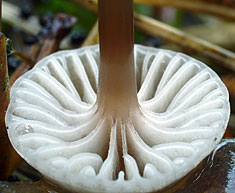Collection date: October 8, 2011
Habitat: Growing in a cluster under a pine
Location: Hiram, ohio
Description: The pileus can be up to 15 mm across, conical to convex, Sometimes with a point in the middle that eventually flattens with age. Striated, lubricous to viscid, darker in the center and becoming paler grey or grey-brown towards the margin. The stipe is hollow and can be straight up or flexuous, glutinous or viscid (Aronsen, 2011).
Collector: Brooke Warren
KeyUsed:Arora, D. (1986). Mushrooms Demystified.New York: Ten Speed Press.
Keying steps:
Key to the Major Groups of Fleshy Fungi
1A. Spores produced on mother cells called basidia; fruiting body variously shaped... Basidiomycotina p. 57
Key to the Basidiomycetes1A. Basidia and spores borne externally (on the exposed surfaces of gills, tubes, spines,
branches, lobes, etc.); spores forcibly discharged at maturity, i.e., a spore print often (but not always) obtainable;
fruiting body with a cap and stalk, or clublike, orbranched, or bracketlike, or crustlike (without a stalk or sometimes without a cap) or lobed or bloblike, etc. ... 2
2B. Not as above... Hymenomycetes p. 58
Key to the Hymenomycetes1B. Not as above; pores and tubes absent... 3
3A. Underside of cap with radiating blades (gills)... Agaricales p. 59
Key to the Agaricales
1B. Not as above; spores forcibly discharged, hence a spore print obtainable if spores are being produced; gills
exposed at maturity; common and widespread... 2
2A. Spore print white to buff, yellow, yellow-orange, or lilac-tinged...3
3B. Neither volva nor warts present (but cap and stalk may have scales or fibrils)... 4
4B. Not as above; veil absent, or if present then gills normally attached to stalk... 6
6B. Not as above; gills usually platelike or bladelike... 7
7B. Not as above... 8
8B. Not with above features... 9
9B. Not as above; gills not normally waxy; stalk central to lateral or absent; on ground or wood...
Tricholomataceae, p. 129
Key to Tricholomateae
1B. Not growing on other mushrooms, or if so then gills well-developed, thin, close... 2
2B. Not as above... 3
3B. Stalk present, well-developed, more or less central; growing on ground or wood... 6
6B. Not as above (but stalk may have a tapered underground "tap root")... 7
7B. Not as above; weil absent, or if present then cap and stalk not granulose... 8
8B. Veil absent or rudimentary and evanescent, not forming an annulus... 9
9B. Not as above... 10
10B. Stalk usually thin and hollow or stuffed and either fragile or cartilaginous (tough), typically 5 mm
thick or less (occassionally thicker but then with a tough cartilaginous outer rind)... 23
23B. Not as above... 24
24A. Cap conical or bell-shaped when young (but may expand in age), often translucent-striate when moist,
margin not usually incurved when young; stalk not polished or tough... Mycena, p. 224
Additional References:
Aronsen, A. (2003). A Key to the Mycenas of Norway. Mycena Page. http://www.bing.com/images/search?q=mycena+vulgaris&view=detail&id=8352DFF86E54B73351BC3E7DF139D3680D52AD9B&first=
0&qpvt=mycena+vulgaris&FORM=IDFRIR
Links:
http://www.mycokey.com/MycoKeySolidState/species/Mycena_vulgaris.html
http://www.bing.com/images/search?q=mycena+vulgaris&view=detail&id=8352DFF86E54B73351BC3E7DF139D3680D52AD9B&first=
0&qpvt=mycena+vulgaris&FORM=IDFRIR
|


No comments:
Post a Comment